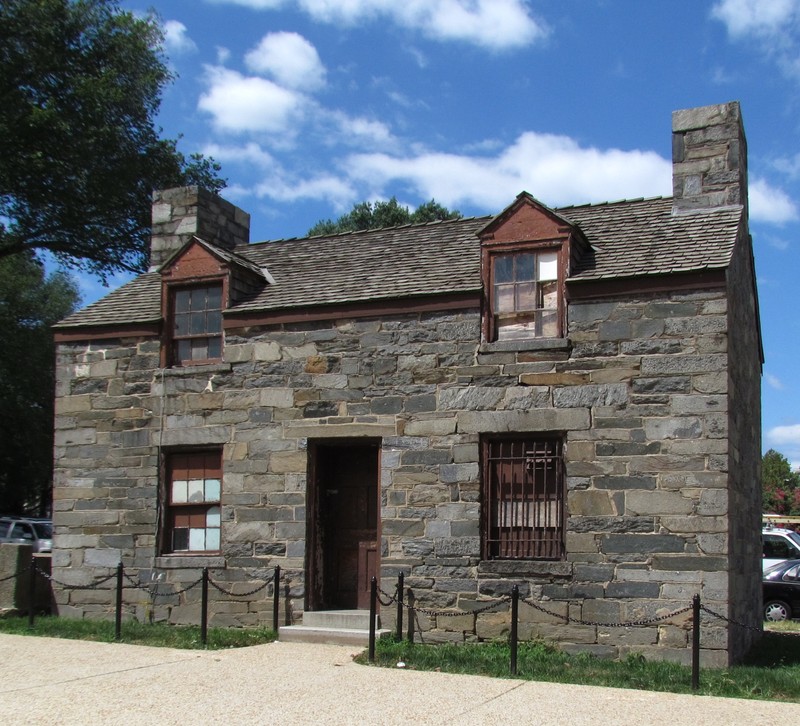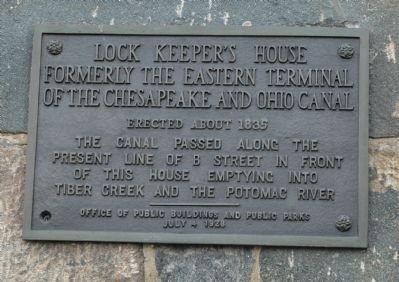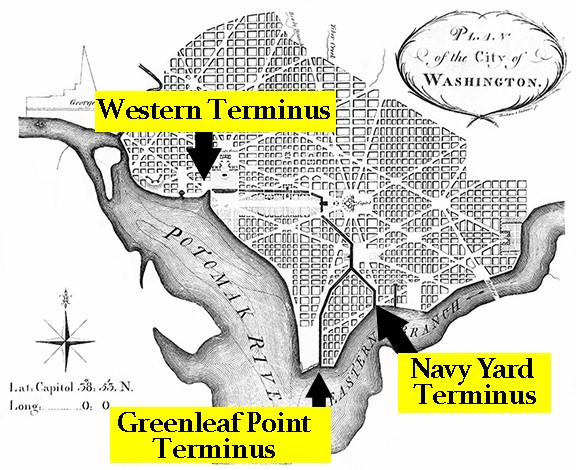Lockkeeper's House
Introduction
Text-to-speech Audio
Images
The Lockkeeper's House was built in 1835 at the eastern terminus of the C&O Canal

This plaque was added to the building in 1928, shortly before it was used as a public restroom

Path of the Washington Canal

Backstory and Context
Text-to-speech Audio
The Washington City Canal was opened in 1815 as a way to bring commerce directly into the city center of Washington, and during this time, the canal system crossing Washington, D.C., and running alongside the mall served to allow small cargo ships to travel between the Potomac and Anacostia Rivers. Prior to the rise of railroads, it was a thoroughfare for goods and people. The cargo included such materials as firewood and coal for fuel, food supplies, as well as marble and stone for public buildings.
However, the canal faced many issues. Even in the best conditions, many boats could not pass through the canal because it had been only dug 3 feet deep. In addition, in construction, the tides had not been accounted for, and during hide tide, the water threatened to flood the city whilst during low tide many stretches of the canal were unusable.
In 1831, the City of Washington bought the canal from the company which operated it because the city believed the canal would lead to more economic development. The city also invested in the Chesapeake and Ohio Canal Company which was building the canal from Georgetown to Cumberland. With a controlling interest, the city forced the C&O Canal Company to create an extension to the Washington City Canal. Two locks were made for the elevation change from Georgetown to Washington. Lock A was located at H and I streets, and Lock B was located at 17th street, the current location of the Lockkeepers house. The extension was constructed in 1832, which is when some believe the lockkeeper's house was constructed. However, the Historic American Buildings Survey taken in 1934-1935 believes that the house was constructed in 1837. The Survey states that this lock house is a surviving example of standard plans for lock houses built along the C&O canal, and was built according to those plans.
The Lockkeepers house itself is a rectangular one and a half story building that measures 30 feet wide by 18 feet deep and has a total square footage of 350 square feet. Originally, the Lockkeepers house was 2 and a half stories, however, when the Washington City Canal was filled, the area around the structure was filled in by one story, reducing the height of the building. It is constructed of fieldstone with a shingled roof and two stone chimneys at each side of the building. It is symmetrically designed in the federal style. The building was the residence of a lockkeeper and his family of thirteen children from 1835 to 1855. The lockkeeper was responsible for collecting tolls and operating the lock on the Washington City Canal. Additionally, he managed the canal connections and kept records.
Nearby residents were often plagued with flooding caused by the canal overflows into the streets and the National Mall. By 1850s, the Washington City canal fell into disuse and became polluted. Unsanitary, costly, and prone to causing accidents, the canal was eventually closed to barge traffic. Twenty years following its closure, the city filled in the Canal and created Constitution Avenue, thus removing the need for a lockkeeper.
The lock keeper's house was abandoned in 1855, except for occasional habitation by squatters. It was partially renovated in 1903 and given to the U.S. government in the early 1900s. It has been used as Park Police headquarters (who used it to keep prisoners), public restrooms, and now storage.
A historical marker on the house includes the following inscription:
Formerly the eastern terminal of the Chesapeake and Ohio Canal. Erected about 1835. The canal passed along the present line of B Street in front of this house emptying into Tiber Creek and the Potomac River.
Sources
"Lock Keeper's House Historical Marker." The Historical Marker Database. Accessed September 25, 2016. http://www.hmdb.org/marker.asp?marker=209.
"Histories of the National Mall Why is There a Lockkeeper's House on the Mall?" Accessed September 25, 2016. http://mallhistory.org/explorations/show/lockkeepers-house.
"Lockkeeper's House." NPS.gov Homepage (U.S. National Park Service). Accessed September 25, 2016. https://www.nps.gov/nr/travel/wash/dc34.htm.
Swain, Claudia . The Rise and Fall of the Washington City Canal, Boundary Stones. August 21st 2015. Accessed January 26th 2021. https://boundarystones.weta.org/2015/08/21/rise-and-fall-washington-city-canal.
Washington Canal, National Park Service. Accessed January 26th 2021. https://www.nps.gov/articles/history-archeology-of-dc-washington-canal.htm.
NATIONAL REGISTER OF HISTORIC PLACES INVENTORY - NOMINATION FORM FOR FEDERAL PROPERTIES, DC Historic Sites. Accessed January 26th 2021. https://dl.dropboxusercontent.com/s/cb5dmabg36kjk25/Lockkeepers%20House%20nom.pdf?dl=0.
Wiener, Talia. 181-Year-Old Lockkeeper's Tiny House Ready For Its Next Chapter, NPR. July 5th 2018. Accessed January 26th 2021. https://www.npr.org/2018/07/05/625669691/181-year-old-lockkeepers-tiny-house-ready-for-its-next-chapter.
Lock Keeper's House, Seventeenth Street & Constitution Avenue, Northwest, Washington, District of Columbia, DC, Library of Congress. Accessed January 26th 2021. https://www.loc.gov/pictures/item/dc0170/.
Architect of the US Capitol
